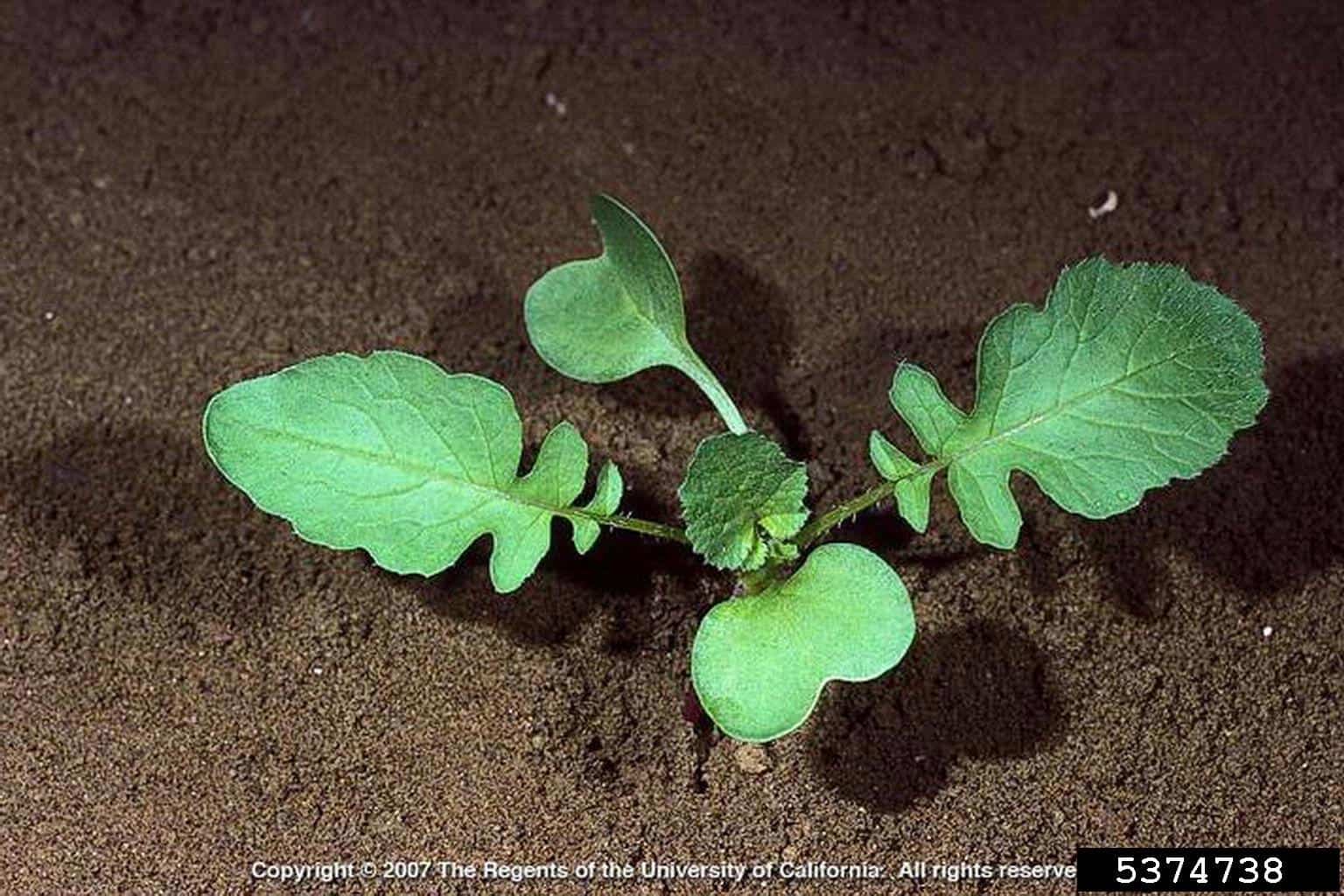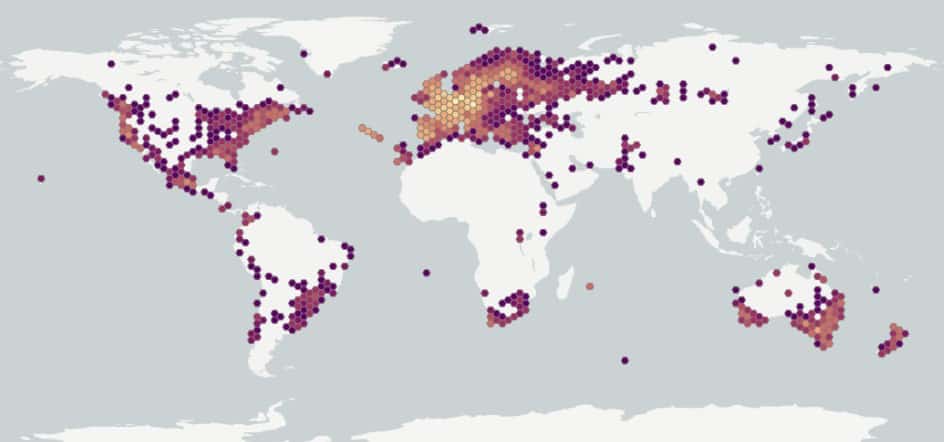Raphanus raphanistrum
Overview
Aperçu
Regulation :
Remarques Réglementation:
- CFIA Weed Seeds Order - Class 2: Primary Noxious Weed Seeds
Regulation Notes:
Distribution :
Répartition :
Native to northern Africa, Europe and western Asia and the Caucasus. Introduced in North and South America, elsewhere in Africa and Asia, Australia and New Zealand (USDA-ARS 2021). It occurs throughout the United States, except for the central region (Kartesz 2015). In Canada, it occurs in all provinces but not in the territories (Darbyshire 2003; Brouillet et al. 2010+).
Habitat and Crop Association :
Habitat et Cultures Associées :
Cultivated fields, abandoned fields, gardens, grasslands, meadows, orchards, woods, cliffs, riverbanks, beaches, dunes, roadsides, railway lines and disturbed areas (Darbyshire 2003; Warwick and Francis 2005). In Canada, Raphanus raphanistrum is a weed of hay, cereals, Zea mays (corn), Brassica napus subsp. napus (canola), Trifolium species (clover), Pisum sativum (peas), Lupinus species (lupins), Solanum tuberosum subsp. tuberosum (potatoes), Fragaria x ananassa (strawberries), Allium cepa (onions), bulbs and Humulus lupulus (hops) (Warwick and Francis 2005).
Economic Use, cultivation area, and Weed Association :
Utilisation économique, zone de culture et association de mauvaises herbes :
Duration of Life Cycle :
Durée du cycle vital:
Annual, winter annual or biennial
Dispersal Unit Type :
Type d’unité de dispersion :
Seed, often shed in silique segment
General Information
RENSEIGNEMENTS GÉNÉRAUX
Raphanus raphanistrum seeds may be dispersed as a contaminant of commercial cereals such as Tritcum aestivum subsp. aestivum (wheat) and Avena sativa (oat) with silique segments a similar size to the grains (Warwick and Francis 2005). The species has demonstrated the ability to hybridize with both Brassica napus subsp. napus (canola) and Raphanus sativus (radish) under controlled experiments and is host to bacterial, fungal and viral diseases that may also affect the contaminated crop (Warwick and Francis 2005).
Approximately 10% of R. raphanistrum are released as seeds (Warwick and Francis 2005). Seed is also dispersed by water and by animals, including birds and cattle. Seeds may remain viable in the soil for 15-20 years (CABI 2021).
.
Raphanus raphanistrum plant (Joseph M. DiTomaso, University of California – Davis, Bugwood.org)
Identification
Identification
-
Silique
Size
- Silique length: 20.0 – 70.0 mm long; width: 3.0 – 6.0 mm (Warwick and Francis 2005)
- Silique segment length*: 4.0 – 5.5 mm; width: 2.5 – 3.0 mm
*Note: minimum and maximum of 5 silique segments in a normal range of this species using specimen measurement (ISMA 2020)
Shape
- Silique is cylindrical, with several transverse constrictions
Surface Texture
- Silique surface longitudinally ridged
Colour
- Silique dull yellow or greyish-brown
Other Features
- A seedless, persistent style is at the end of the silique 10.0 – 30.0 mm long (Warwick and Francis 2005)
- 1 – 10 seeds per silique (Warwick and Francis 2005)
- The silique breaks apart into one-seeded, barrel-shaped segments at the constrictions (FNA 1993+; Warwick and Francis 2005)
- Plants growing in coastal habitats may have smooth, inflated siliques without constrictions (Warwick and Francis 2005)

Wild radish (Raphanus raphanistrum) seeds and pods

-
Seed
Size
- Seed length: 2.5 – 4.5 mm; width: 2.3 – 3.5 mm
*Note: minimum and maximum of 10 seeds in a normal range of this species using specimen measurement (ISMA 2020)
Shape
- Seed oblong to oval shaped with rounded ends, slightly compressed longitudinally
Surface Texture
- Seed surface ridged reticulate
Colour
- Seed shiny reddish-brown or brown with a dark brown area at the hilum end
- Reticulations are generally the same colour as the seed
Other Features
Hilum & Hilum area
- Hilum end is marked with a circular dark brown area, a small raised dot and a line of whitish tissue between them
- Ridged reticulations can be white at the hilum end of the seed
Other Features
- A groove from the hilum end between radicle and cotyledons, extends almost to the end of the seed
- Seed not mucilaginous when wetted (FNA 1993+)

Wild radish (Raphanus raphanistrum) seed



-
Embryo
Size
- Embryo fills the seed
Shape
- Embryo is simple folded
Endosperm
- Endosperm is scant or lacking, nutritive tissue contained within cotyledons
Other Features
- Cotyledons are oval shaped, soft and yellow coloured
Identification Tips
CONSEILS POUR L’IDENTIFICATION
Species in the Brassicaceae that have siliques with constrictions and oval shaped, compressed seeds with ridged reticulation include Raphanus species and Rapistrum species. Seeds of Raphanus raphanistrum are larger than Rapistrum species, and can be smaller than R. sativus.
When there is a size overlap between R. raphanistrum and R. sativus seeds, other seed features are used to distinguish them. Compared to R. sativus seeds, R. raphanistrum seeds are generally darker reddish brown coloured, not as strongly compressed longitudinally, and do not have a narrowed end opposite the hilum.

Wild radish (Raphanus raphanistrum) seed



Additional Botany Information
AUTRES RENSEIGNEMENTS BOTANIQUES
Flowers/Inflorescence
- R. raphanistrum generally has yellow flowers, rarely white with purple veins, and R. sativus is white-flowered (Warwick and Francis 2005)

Raphanus raphanistrum flowers (Rebekah D. Wallace, University of Georgia, Bugwood.org)





Similar Species
ESPÈCES SEMBLABLES
Similar species are based on a study of seed morphology of various species, and those with similar dispersal units are identified. The study is limited by physical specimen and literature availability at the time of examination, and possibly impacted by the subjectivity of the authors based on their knowledge and experience. Providing similar species information for seed identification is to make users aware of similarities that could possibly result in misidentification.
Raphanus sativus L. (radish)
R. sativus seeds (length*: 2.7 – 4.2 mm; width: 1.8 – 3.2 mm) are a similar size, a lighter colour from white ridged reticulation, generally have a more narrow end opposite the hilum, compressed longitudinally with thicker ridged reticulation than in R. raphanistrum. R. sativus seeds are reported to have a pigmented layer under the surface layers of the seed that R. raphanistrum lacks (Warwick and Francis 2005).
*Note: minimum and maximum of 10 seeds in a normal range of this species using image measurement (ISMA 2020)
Click to select species
Cliquez pour sélectionner les espèces

Raphanus sativus
Comparison Window
Fenêtre de comparaison
MAIN SPECIES
ESPÈCES PRINCIPALES
Raphanus raphanistrum

Raphanus raphanistrum
Brassicaceae
Wild radish (Raphanus raphanistrum) seeds and pods
MAIN SPECIES
ESPÈCES PRINCIPALES
Raphanus raphanistrum

Raphanus raphanistrum
Brassicaceae
Wild radish (Raphanus raphanistrum) seed
MAIN SPECIES
ESPÈCES PRINCIPALES
Raphanus raphanistrum

Raphanus raphanistrum
Brassicaceae
Wild radish (Raphanus raphanistrum) seed, hilum view
SIMILAR SPECIES
ESPÈCES SEMBLABLES
Raphanus sativus

Raphanus sativus
Brassicaceae
Radish (Raphanus sativus) seeds
SIMILAR SPECIES
ESPÈCES SEMBLABLES
Raphanus sativus

Raphanus sativus
Brassicaceae
Radish (Raphanus sativus) seeds
SIMILAR SPECIES
ESPÈCES SEMBLABLES
Raphanus sativus

Raphanus sativus
Brassicaceae
Radish (Raphanus sativus) seed
Need ID Help?
Besoin d’aide pour l’identification?
Reference(s)
Référence(s)
Brouillet, L., Coursol, F., Meades, S. J., Favreau, M., Anions, M., Bélisle, P. and Desmet, P. 2010+. VASCAN, the database of vascular plants of Canada. http://data.canadensys.net/vascan/ Accessed April 27, 2021.
Centre for Agriculture and Bioscience International (CABI). 2021. Invasive Species Compendium, CAB International, Wallingford, UK. https://www.cabidigitallibrary.org/journal/cabicompendium Accessed April 27, 2021.
Darbyshire, S. J. 2003. Inventory of Canadian Agricultural Weeds. Agriculture and Agri-Food Canada, Research Branch. Ottawa, ON.
Flora of North America (FNA) Editorial Committee, eds. 1993+. Flora of North America North of Mexico [Online]. 22+ vols. New York and Oxford. Accessed December 29, 2022.
Global Biodiversity Information Facility (GBIF) Secretariat. 2022. https://doi.org/10.15468/39omei Accessed via https://www.gbif.org/species/3040983 Accessed December 29, 2022.
Government of Canada (GC). 2016. Canadian Weed Seeds Order. https://laws-lois.justice.gc.ca/eng/regulations/SOR-2016-93/page-2.html (English) https://laws-lois.justice.gc.ca/fra/reglements/DORS-2016-93/page-2.html (French)
International Seed Morphology Association (ISMA). 2020. Method for Seed Size Measurement. Version 1.0. ISMA Publication Guide.
Kartesz, J. T. 2015. The Biota of North America Program (BONAP). North American Plant Atlas. Chapel Hill, N.C., www.bonap.org/MapSwitchboard.html Accessed April 27, 2021.
U.S. Department of Agriculture-Agricultural Research Services (USDA-ARS). 2021. Germplasm Resources Information Network (GRIN), https://npgsweb.ars-grin.gov/gringlobal/taxon/taxonomysimple.aspx Accessed April 27, 2021.
Warwick, S. I. and Francis, A. 2005. The biology of Canadian weeds. 132. Raphanus raphanistrum. Canadian Journal of Plant Science 85: 709-733.




